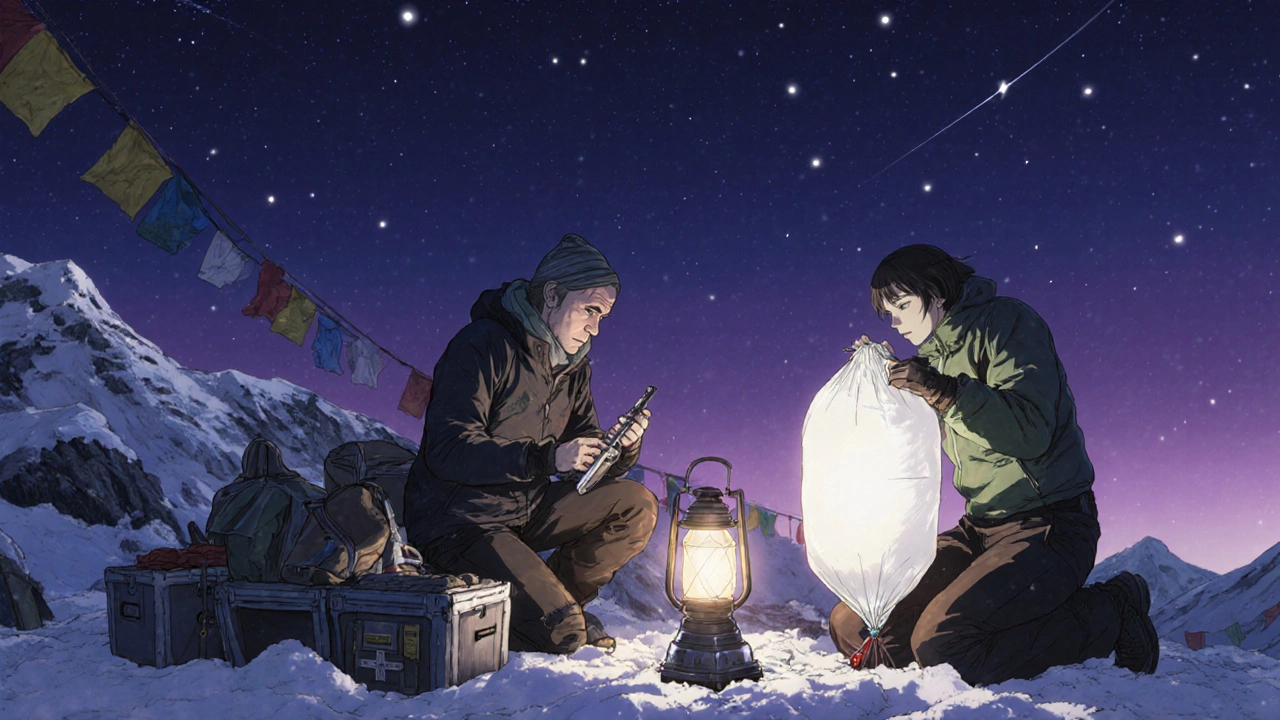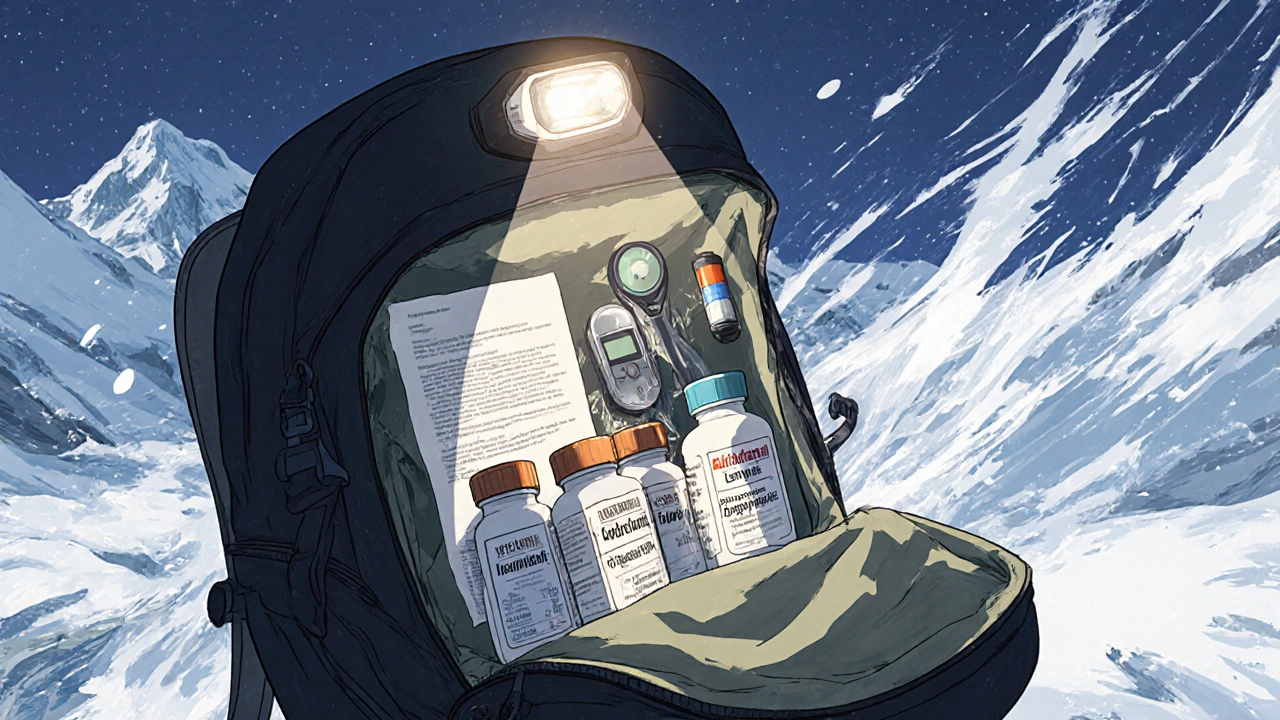Imagine climbing to 17,500 feet, your breath ragged, your head pounding, and you realize you left your acetazolamide at home. Or worse-you packed it, but the cold at night turned your insulin into useless sludge. This isn’t a horror story. It’s what happens to thousands of pilgrims and trekkers every year because they didn’t plan for medication needs in extreme environments.
High-altitude pilgrimages like Mount Kailash, the Camino de Santiago at elevation, or Everest Base Camp aren’t just spiritual or physical challenges-they’re medical ones. At altitudes above 8,000 feet, your body starts struggling to get enough oxygen. That’s when Acute Mountain Sickness (AMS) kicks in. Around 25% to 85% of people ascending this high get symptoms: headaches, nausea, dizziness. If ignored, it can turn into life-threatening High Altitude Pulmonary Edema (HAPE) or High Altitude Cerebral Edema (HACE). And in remote areas, help might be 24 to 72 hours away.
Know Your Medications-Before You Leave
You can’t wing it with meds on a trek. The right drugs aren’t optional-they’re essential. Here’s what you need to carry, and why.
Acetazolamide (Diamox) is the gold standard for preventing altitude sickness. It works by making you breathe faster, helping your body adjust. The standard dose is 125 mg twice a day, starting one day before you begin ascending and continuing for three days after reaching your highest point. About 67% of users report increased urination and tingling fingers-annoying, but far better than vomiting at 15,000 feet. If you have a sulfa allergy (3-6% of people), skip this. Talk to your doctor about alternatives.
Dexamethasone is a steroid used for treating severe HACE. It’s not for prevention-it’s for emergencies. The protocol: 8 mg initially, then 4 mg every six hours. It reduces brain swelling fast. But it doesn’t replace descent. If you’re using this, you’re in a crisis. Carry it, but never rely on it as a substitute for slow climbing.
Nifedipine (extended-release) is for HAPE. It opens up constricted lung arteries. The dose is 20 mg every 12 hours. It’s not something you take daily-it’s a rescue drug. Keep it in your first aid kit, not buried in your backpack.
Don’t forget the basics: ibuprofen (400 mg) for headaches and inflammation, azithromycin (500 mg daily for three days) for traveler’s diarrhea (which affects 60% of trekkers at 9,000-14,000 feet), and diphenhydramine for allergic reactions or sleep aid. Pack antibiotic ointment and hydrocortisone cream too. Skin rashes and infections are common when you’re sweating, dusty, and washing with glacier water.
Storage Matters More Than You Think
Medications don’t care if you’re on a spiritual journey. They’re chemicals. And cold, heat, and moisture destroy them.
Insulin? It degrades 25% in just 24 hours if it drops below 32°F (0°C). Glucometers? They give wrong readings below freezing-error rates jump to 18% at 14°F (-10°C). A Reddit user lost $4,200 to a medical evacuation because their insulin failed at 14,000 feet. That’s preventable.
Use insulated, waterproof containers. Some people use hand warmers wrapped in cloth next to insulin vials to keep them just above freezing. Others buy portable fridge packs designed for travel meds. The CDC recommends keeping meds between 59-77°F (15-25°C). If you’re camping in snow, keep your meds inside your sleeping bag at night.
Never leave pills in your daypack while hiking under the sun. Heat in a backpack can hit 120°F. That’s enough to ruin antibiotics, thyroid meds, or epinephrine auto-injectors.
Bring the Right Documentation
If you’re carrying controlled substances-painkillers like oxycodone, ADHD meds, or even strong anti-anxiety drugs-you need paperwork. The U.S. Drug Enforcement Administration (DEA) and international narcotics boards require permits for some drugs. About 17% of trekking groups hit this roadblock. Don’t be one of them.
Carry all medications in their original pharmacy bottles with clear labels. No ziplock bags. No unlabeled pills. Border agents and airline security will stop you. A letter from your doctor explaining what you need, why, and the dosage is non-negotiable. Print two copies. Keep one in your carry-on, one in your checked bag.
Some countries, like Nepal and India, have strict rules on importing meds. Check ahead. If you’re going to Lhasa, Tibet, or remote parts of Peru, confirm your meds are legal. Local pharmacies? Don’t count on them. A 2013 survey found 89% of health camps on pilgrimage routes didn’t stock acetazolamide, dexamethasone, or nifedipine.

Plan for Your Chronic Conditions
Diabetes, asthma, heart disease, epilepsy-these don’t disappear when you hit the trail. They get worse.
Diabetics need double the insulin. Pack extra syringes, test strips, and batteries for your glucometer. Bring a backup meter. Test your blood sugar more often. Stress and altitude affect glucose levels unpredictably.
Asthma sufferers? Bring two inhalers. Cold, dry air triggers attacks. A 2022 survey of trekkers found 34% had medication-related issues-47% of those were running out of meds. Don’t be that person.
People with heart conditions should get a stress test before going. At high altitude, your heart works 30-40% harder. If your doctor says no, listen. There’s no shame in skipping a pilgrimage if your body can’t handle it.
Ascent Strategy Is Your Best Medicine
No pill replaces slow climbing. The best way to avoid altitude sickness is to go up slowly. The rule? No more than 1,000 feet (305 meters) elevation gain per day above 10,000 feet. Rest every third day. Drink 4-5 liters of water daily. Don’t sleep during the day-your body needs oxygen, not naps.
But pilgrims often fly into high-altitude cities like Lhasa (12,000 ft) or Cusco (11,000 ft). That’s a problem. You need at least two full days to acclimatize before starting any trek. Many ignore this. That’s why so many end up in tents with oxygen masks.
Some trekking companies now offer pre-acclimatization programs-staying at intermediate altitudes for a few days before the main climb. It’s worth the extra cost.

Prepare for the Worst
Even with perfect planning, things go wrong. That’s why a hyperbaric bag (like a Gamow Bag) is a game-changer. It simulates lower altitude by pressurizing a portable chamber. It’s not common, but it’s lifesaving. Fewer than 5% of health camps have one, but if you’re leading a group, carry one. It buys you hours to get someone down.
Also, train your group. Everyone should know how to recognize AMS symptoms: headache, nausea, confusion, coughing with pink froth (HAPE), loss of coordination (HACE). If someone has these, don’t wait. Descend immediately. No exceptions.
And always tell someone your route and expected return time. If you collapse at 16,000 feet, someone needs to know where to look.
What’s Changed in 2025
Things are improving. Nepal’s 2021 Altitude Sickness Prevention Campaign distributed 15,000 medication kits to trekking agencies. Hospitalizations dropped 22%. More clinics now stock acetazolamide and dexamethasone.
By 2027, 95% of high-altitude trekking companies will require pre-trip medical consultations-up from 68% in 2023. Insurance companies are pushing for it. Liability is too high to ignore.
Wilderness Medical Society is rolling out standardized medication kits for three altitude zones: below 10,000 ft, 10,000-15,000 ft, and above 15,000 ft. Pilot testing starts in Q2 2024. You might soon be able to buy a pre-packed kit designed for your route.
For now, the best solution is still you-prepared, informed, and respectful of the altitude. Don’t treat it like a hiking trail. Treat it like a medical zone. Because it is.
Can I buy altitude sickness meds at local pharmacies on the trail?
Don’t count on it. A 2013 survey found 89% of health camps along major pilgrimage routes didn’t stock acetazolamide, dexamethasone, or nifedipine. Even if you find a pharmacy, the meds might be expired or counterfeit. Always bring your own supply in original containers.
Do I need a doctor’s note for my medications?
Yes-if you’re carrying controlled substances like opioids, ADHD meds, or strong anxiety drugs. Even for non-controlled meds, a doctor’s letter explaining your condition and dosage helps avoid delays at borders or airports. Keep a printed copy in your carry-on and a backup in your checked bag.
How much water should I drink at high altitude?
Drink 4 to 5 liters daily. At altitude, you lose more fluids through breathing and sweating. Dehydration worsens altitude sickness. Don’t wait until you’re thirsty. Sip constantly. Avoid alcohol and caffeine-they dehydrate you more.
Is it safe to take Diamox if I have a sulfa allergy?
No. Acetazolamide is a sulfa-based drug. If you have a sulfa allergy (which affects 3-6% of people), you could have a severe reaction. Ask your doctor about alternatives like dexamethasone for prevention or using a slower ascent profile.
What should I do if someone in my group shows signs of HACE?
Act immediately. Give them 8 mg of dexamethasone, then 4 mg every six hours. Start descending-no delay. Even 1,000 feet down can save their life. Use a hyperbaric bag if you have one. Call for help. Never wait to see if they get better. HACE can kill in hours.
Can I bring my insulin in my carry-on on a flight to a high-altitude destination?
Always. Never check insulin. Baggage holds can drop below freezing. Airlines allow insulin and syringes in carry-ons with a doctor’s note. Keep it in an insulated pouch. Test your blood sugar before boarding-stress and altitude changes can spike or drop levels.
How do I know if my medication has gone bad?
Look for changes: discoloration, clumping, strange smell, or liquid leaking from pills. Insulin that looks cloudy or has particles isn’t safe. Glucometer strips that don’t react properly after testing with known control solution are unreliable. When in doubt, replace it. Your life isn’t worth the risk.
Are there any vaccines I need for high-altitude pilgrimages?
Altitude itself doesn’t require vaccines, but the destination does. For Nepal, India, or Peru, get Hepatitis A, Typhoid, and Tetanus. If you’re near livestock, consider Rabies. Diarrhea is common-so pack oral rehydration salts and azithromycin. The CDC Yellow Book has updated recommendations for every country.

